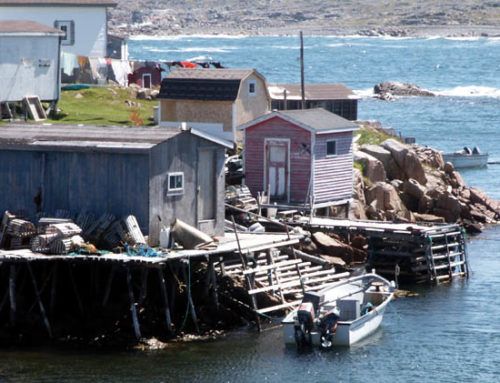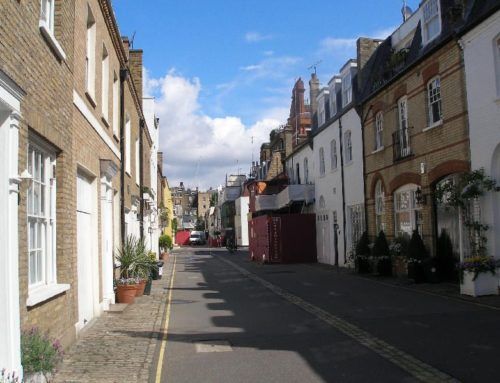A Visit to Switzerland’s Lötschental
With dwindling dairies, is tourism the answer to keep the Lötschental Valley’s charm?

In his global travels during the 1930s, Weston A. Price sought out locations where people were not yet eating what he called the “displacing food of modern commerce.” One of the places Price visited was Switzerland’s Lötschental—an isolated valley then only accessible by a footpath. It was so isolated from the rest of Switzerland, let alone the world, that the residents existed on what they could grow in the valley, with no food brought in from outside, with the exception of salt.
Their diet primarily consisted of dairy products (raw milk, butter, cream and raw milk cheese) from cows grazing on lush alpine slopes, and rye bread, or roggenbrot, from rye grown in the valley. They ate meat about once a week, usually veal, using all the parts and making soup with the bones, and some vegetables during the summer months. The raw milk, butter and cream from cows eating lush green grass were a rich source of vitamins A and D.
With the help of a Swiss dentist who was his travel companion and the community elders Price was able to examine the mouths of many valley inhabitants. He reported that the majority of the residents had healthy, straight teeth. Price only found one cavity in every three mouths, which was about 1 percent tooth decay. Both adults and children had broad, well-developed faces and palates, good dispositions and sturdy bodies. He noted that the children played barefoot in frigid streams during cold weather and that there were no cases of TB in the valley.
In other parts of Switzerland, Price studied the “modernized Swiss,” who lived in towns accessible by roads and therefore got their food from stores selling sugar, white flour, pastries, jams and jellies, canned condensed milk, canned foods and vegetable oils. They were experiencing dental caries in one tooth in three, or 33 percent tooth decay, and the younger generations had dental deformities, overlapping, crowded and crooked teeth and narrow faces. TB was a huge problem in these communities.
REVISITING THE VALLEY

The church in Wiler as seen by Weston A. Price.
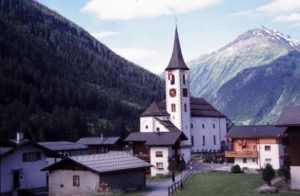
The church in Wiler in 2003
In June of 2003, about 70 years after Price’s visit, I revisited the Lötschental. The valley consists of four small picturesque towns accessible by car and bus from the entrance of the valley near the train station. At the far end of valley is a glacier. If you look at page 24 of Price’s tome Nutrition and Physical Degeneration, you will see a picture of a church that Price took in the 1930s–it is the same church I photographed (see left). The Wiler church still proudly stands and plays a prominent role in Herrgottsgrenadiere, or “God’s soldiers,” a June celebration that honors soldiers coming home from foreign battles. When they returned home, they saved the parade uniforms to wear for church festivities. Price described the good health and sturdiness of the Lötschental men who often took jobs in the Pope’s Swiss Guard. They also served the kingdoms of Versailles and Naples and were mercenaries in foreign countries.
The day after I arrived, the locals were constructing mini altars to honor the Virgin Mary, several in each of the valley towns. The backdrop for each altar was pine branches cut from the alpine forest. On the next day, the soldiers assembled and ceremonially marched to the church, with the townspeople in tow, for a special mass. Despite all this religious activity, there was no evidence of an ancient ceremony recalled by Price—lighting a wick in a bowl of the first spring butter—to honor the life-giving force contained therein (Price, p. 26). According to Price, the wick was permitted to burn in a special sanctuary built for the purpose. At least back then, the natives recognized the superior quality of their June butter, perhaps without really understanding why. To be fair, language was a barrier, so I might not have been able to express myself when trying to explain my search for remnants of this ceremony. But at least on the days I was there, in the churches I looked in, I saw no such ceremony. At first impression, it seems that this ceremony is now forgotten.
VANISHING AGRICULTURE
Lötschental Tourism always ends their emails with the signature, Freundliche Grusse aus dem Tal der Taler, or “Friendly Greeting from the Valley of Valleys.” It is a beautiful valley and one to be proud of for its majestic scenery and beautiful architecture.
Above the towns situated on the valley floor, cows graze on the alpine pasture. Half way up the mountains on the southern side lies the Hohenweg, a walking path that is a perfect viewing point to see the northern side of the valley composed of the beautiful Bietschhorn range.
However, what I saw in the valley was a culture in danger of losing its agricultural roots. To be blunt, junk foods abounded. While our half-board arrangement at the hotel gave us a good breakfast with cheese and bread in the morning and a hot meal for the evening meal, it was hard to find good food in the stores. And we were served pale, commercial butter with each meal instead of golden alpine butter, rich in nutrients. Some restaurants still serve rye bread and raw milk cheese as an entrée or appetizer, but most of the small stores all over Valais, the canton of Switzerland in which the Lötschental lies, are filled with processed foods like chips, candy and soft drinks. Oftentimes, alpine butter sat next to ultra-high temperature pasteurized (UHT) milk on the grocery shelf. Switzerland is, after all, headquarters to Nestlé.
DWINDLING DAIRIES
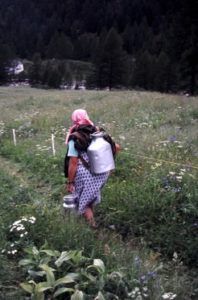 During our stay in the valley, we learned that the inhabitants are slowly abandoning farming due to the fact that they cannot make a living wage. Over the past few decades a large exodus from the valley to look for work has left the older inhabitants to take care of the dwindling dairies. Most of these workers are women. When I finally sufficiently explained my desire to the valley tourism officials to see “cows and milk,” I was taken to a spot off the main valley road called Chiemad—Kühmad, or “cow path.”
During our stay in the valley, we learned that the inhabitants are slowly abandoning farming due to the fact that they cannot make a living wage. Over the past few decades a large exodus from the valley to look for work has left the older inhabitants to take care of the dwindling dairies. Most of these workers are women. When I finally sufficiently explained my desire to the valley tourism officials to see “cows and milk,” I was taken to a spot off the main valley road called Chiemad—Kühmad, or “cow path.”
With our guide in lead, we walked up a very long steep hill through a pasture towards a lean-to in the far distance. I was told this is where we would find some cows and hopefully some signs of activity and someone to interview. My son and I were rapidly loosing steam and were out of breath, when we saw a dairywoman approaching at fast pace down the path we were struggling so hard to ascend. I asked the tourism official to ask her to stop so I could take a picture, but he would not. So, I tried to get her attention, but she just kept moving—either ashamed or shy of getting her picture taken. Hence, I got pictures of her coming and going, with a 50-pound container of milk strapped to her back. As she continued to descend, he kept going up the pasture towards the aforementioned lean-tos. When we arrived, we found a couple of cows in the shack resting after having been milked. I was told they would probably stay there the night and be let out the morning to forage on the alpine grass and flowers again. By the time we were finished looking around, the woman had disappeared.
The morning of my departure, I was determined to make a deeper connection to what appeared to be the vanishing dairy culture of the valley. Unable to persuade the tourism officials to take me to a high-alpine dairy above 3,000 meters, I decided to camp out at the valley’s main cheese factory in Wiler to see who came to deposit their morning milk. First, a local milk lady arrived with milk cans on a humble pull cart. After about a half hour, a muscular and tanned woman arrived with several milk cans piled in the back of her SUV. She had just milked her cows on the high-alpine pasture and had driven the milk down to the dairy. She only spoke German, so I interviewed her with my intermediate German skills. I found out that she only had six cows and spent the summer living with them at high altitude. I so wished I had been introduced to her on the day of my arrival.
Through my research, I learned that the main Lötschental dairy makes three kinds of cheese. First, there is Lötschental Mutschli, which is made from both raw and pasteurized milk and is formed into small wheels weighing one-half to one kilogram, and then aged 6-12 weeks. Throughout the Valais, Mutshcli is championed as a cheeese that captures the taste of alpine flora. The bulk of the valley’s milk goes into cut cheese, a second kind of cheese in which the curdled milk is cut to produce curds and then pressed to express the whey and form 2-5 kg wheels or logs. Twelve tons of milk per year go into Lötschentaler cut cheese.
My favorite is the third kind of Lötschental cheese, Hobel käse, a hard cheese made exclusively from raw milk that is typically fashioned into large wheels and then aged 1-3 years. Unfortunately, the dairy store was never open for business when I passed by—and definitely not early in the morning when the dairywomen come to deposit their milk.
When I got home, I decided to contact the Swiss government to obtain agriculture data about the valley. Although it took a few months, I was finally presented with some astoundingly interesting data from the Census of Agricultural Establishment that dates back to the 1920s. Since agriculture has historically been very important to Switzerland, the government has gathered agricultural data for decades. That data includes the number of agriculture establishments in the Lötschental, obtained by combining data from all four villages. In 1929, the Lötschental was home to 205 farms and employed 690 farm workers aged 15 or older, but by the year 2000, the official number of farms had fallen to 75 and the full-time workers to 13.
| Date | No. of farms | Full-time workers |
| 1929 | 205 | 690 |
| 1939 | 228 | 742 |
| 1955 | 215 | 374 |
| 1965 | 185 | 86 |
| 1975 | 143 | 20 |
| 1085 | 128 | 29 |
| 1996 | 104 | 26 |
| 2000 | 75 | 13 |
In graph form, the data looks like this:
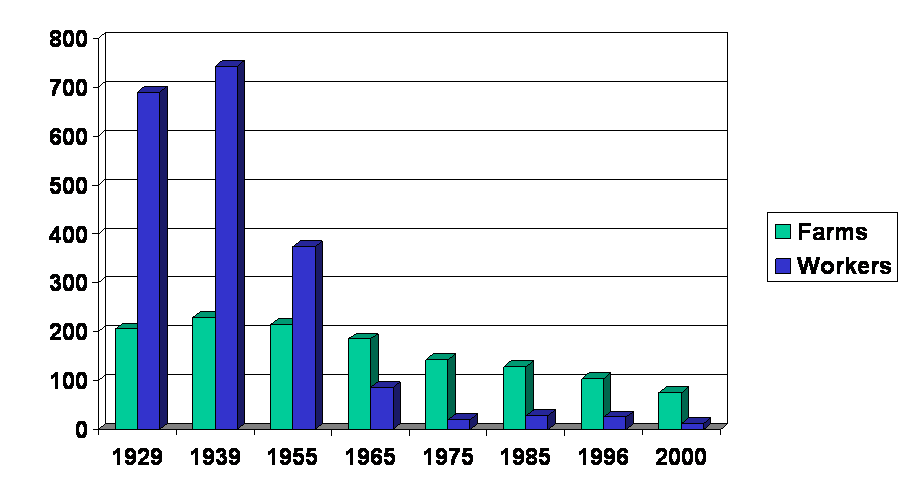
Another source of data was the Federal Population Census, which counts not only people but livestock as well. Although the dates don’t quite match, these figures show the number of “milking cows” in the Lötschental over almost seven decades—and tell a similar story.
| Year | No. of cows producing milk |
| 1936 | 357 |
| 1951 | 349 |
| 1966 | 347 |
| 1978 | 214 |
| 1985 | 143 |
| 1996 | 126 |
| 2000 | 89 |
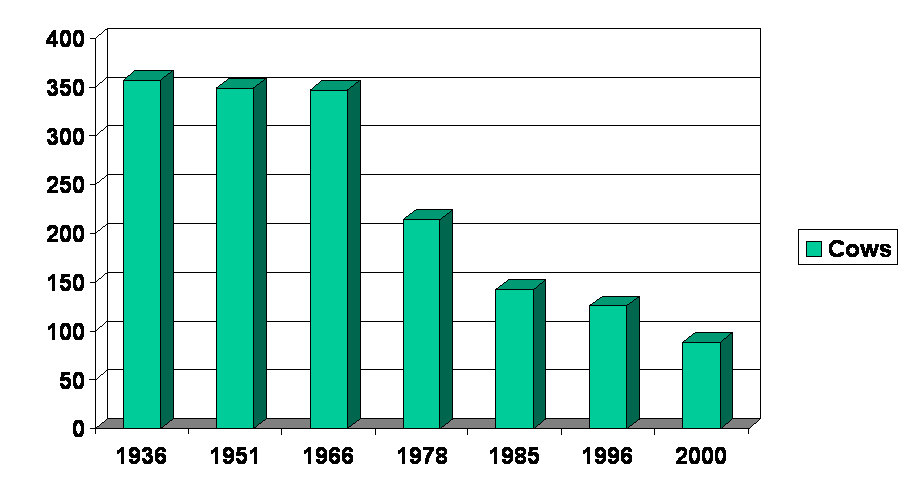
IS TOURISM THE ANSWER?
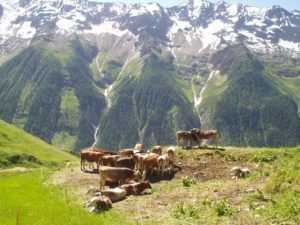 I have come to believe that agritourism might be key to turning the valley around and helping to preserve and restore its agricultural roots. By 2020, tourism will be the number one business in the world. A recent Tourism Industry of America study co-sponsored by the Smithsonian revealed that 81 percent of adult US travelers in 2003 were historic/cultural travelers, that is, they traveled with a purpose to learn about culture/history. Agritourism is a growing segment of cultural heritage tourism and has the potential to play an important role in the growth and maturation of the industry.
I have come to believe that agritourism might be key to turning the valley around and helping to preserve and restore its agricultural roots. By 2020, tourism will be the number one business in the world. A recent Tourism Industry of America study co-sponsored by the Smithsonian revealed that 81 percent of adult US travelers in 2003 were historic/cultural travelers, that is, they traveled with a purpose to learn about culture/history. Agritourism is a growing segment of cultural heritage tourism and has the potential to play an important role in the growth and maturation of the industry.
Unfortunately, the valley has made some steps to embrace ski tourism as a path to economic recovery. In fact, some of the pastures along the Hohenweg have already been lost to ski chalets. Although agritourism has a lot of potential, the valley currently lacks organization and adequate infrastructure, so initially we, as members of the Weston A. Price Foundation, may be trying to get more out of the valley than it offers. (I did not find one person who knew who Weston A. Price was or had heard of his travels to the valley.)
Distance and language are big barriers to pursuing strategic alliances with stakeholders in the valley, as well as in the whole region. Although I conveyed my goals in writing before I traveled to the valley, tourism officials there seemed unable to understand why someone would want to see cows or drink raw milk. (If they had more clearly communicated my desire, my hotelier could have had fresh raw milk from a local farm on the breakfast table each morning.) In essence, the local stakeholders need to be educated about our expectations.
GREAT DAY TRIPS
In addition to attractions in the valley, such as the Lötschental Museum and walking the Höhenweg, there is plenty to see and do in the surrounding area that is readily accessible with the trains and buses at your disposal with a Swiss Pass. Other towns that Price visited in the 1930s were Visperterminen, St. Niklaus and Grächen (Price, pp 28-34). Visperterminen is famous as the home to the highest vineyards in Europe. There, high above the Rhone, grapes afforded these villagers additional nutrition not available in Lötschental. As I wandered the streets of Visperterminen, I found a wonderful old house with an amazing motif of bread, grapes and cheese engraved on its garden wall.
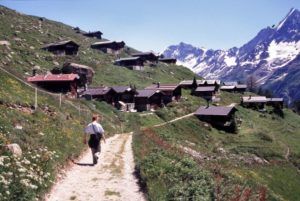
My second son Robert on the Hohenweg.
The small town of St. Niklaus is a stop on the train that goes to the Matterhorn and its glacier. Grächen is a short bus ride from St. Niklaus and one can walk between the two towns in the summer months. I would spend my time here rather the carrying on to the Matterhorn and its tourist trap gateway city of Zermatt. A more impressive glacial destination is the Jungfrau Aletsch Bietschhorn, designated a UNESCO World Heritage Site in 2001. The glacier sits just over the end of the Lötschental, but you must go all the way around to get to it.
I would reserve at least one day for visiting the town of Leukerbad, a historic town famous for its Roman baths. Every Saturday and Sunday buses from the Goppenstein train station carry you directly there. Otherwise, you need to take the train to Brig and change for the train to Leuk—then take a bus up to Leukerbad. Also, remember to make a spa reservation.
Another interesting day trip destination is Erschmatt. In the tiny town of Erschmatt, one can visit the Sortengarten, a garden devoted to the alpine species of Valais, including the regional rye that has been used for millennia to make the region’s traditional sourdough rye bread. Although one no longer sees the huge loaves that Price saw, groups of 6-12 people can arrange to attend a Backerlebnis, or a breadbaking experience where you make, and then bake, your own normal-sized loaf of bread.
Last, but not least, do not forget the regional wine. Although no grapes are grown in the Lötschental, the climate of the nearby Rhone Valley is well suited for grapes. Terraced vineyards along the Rhone are home to the largest wine region of Switzerland. Although water is sometimes scarce, thus making irrigation necessary, generous sunshine and good temperatures make the steep, south-facing slopes along the Rhone ideal for wine growing. In fact, there are some 20,000 Valaisan vintners. The most famous regional wines are Dôle du Valais (red), Johannisberg (white), and Fendant (white). May I suggest taking a stroll along the six-kilometer Sierre-Salgesch Wine Path, which starts in the town of Sierre at a wine museum that houses a restaurant famous for its Valaisian wine and cheese.
And when it’s time to go home, do buy some Valaisian cheese to take with you. In general, the raw milk cheeses of Europe are endangered due to the threat of overzealous EU sanctions. To support and strengthen cultural traditions worth preserving, and to help the farmers make a living wage through direct sales to consumers, buy directly from the farm if possible. It is legal to bring cheese into the United States that has been aged 60 days or longer, so do declare it or it could be taken away by the USDA at the airport.
For more information:
Switzerland Tourism, http://www.myswitzerland.com
Valais Tourism, http://www.matterhornstate.com
Lötschental Tourism, http://www.loetschental.ch
Swiss Pass (for the railroad)
http://www.raileurope.com/us/rail/passes/swiss_pass.htm
Hotel Edelweis, http://www.hoteledelweiss.ch
Leukerbad Spa, http://www.leukerbad.ch
Erschmatt and making roggenbrot, http://www.roggenbrot.ch
Sierre-Salgesh Wine Path, Museum/Restaurant,
http://www.walliserweinmuseum.ch
TRAVEL SUGGESTIONS
For those interested in conducting a self-directed tour of the valley and nearby Valaisian destinations, here are some suggestions:
What is the best time of year to go? Although the valley and region has tourist offerings all year long, I believe summer is the best time to see the remnants of its milk culture. As discussed, June is the time for Herrgottsgrenadiere, but an equally compelling time to go would include August 1st, which is Switzerland’s National Day. Price must have traveled to the valley around this time as he mentioned seeing bonfires on this day up and down the valley (Price, p.27).
What is the best way to get there? I would recommend flying to Zurich on your favorite carrier. From Zurich, the journey to the valley is seamless. Swiss trains and buses link the capital to the valley like Swiss clockwork—they always run on time. Purchase a Swiss Pass and you will have passage on all trains, buses and lake steamers without having to buy individual tickets, except for the Matterhorn. It is imperative to purchase your Swiss Pass before leaving home, as they cannot be purchased abroad. The only other vital step to remember is to have it validated at first entry prior to use. If your entry point is the Zurich airport, you will see directions to where to validate your pass before getting on the train. Another option is to fly to Paris and take the TGV from Paris/Gare Lyon to Brig, a town in the Rhone valley just below the Lötschental. However, you might have to spend a night in Paris.
Some tips on luggage: Do not bring too much luggage. Some Swiss trains are very high and you will have to lug whatever you are carrying up and down some steep steps, sometimes six feet off the ground, when getting on and off the train.
Where to stay? Our home base in the valley was Hotel Edelweiss—a quaint and neatly appointed chalet hotel in town of Blatten. The hotel, located over a rushing mountain stream near where it converges with a glacial stream, offers half board and stunning mountain views—especially at dusk. While we were out and about doing research during the day, my son and I made a point to be back to the hotel in time to see the last rays of the sun vanish from the peaks of the Bietschhorn from the veranda.

